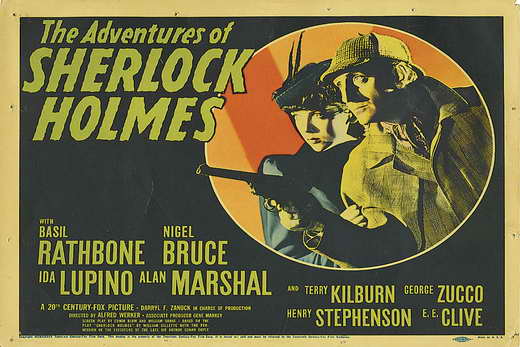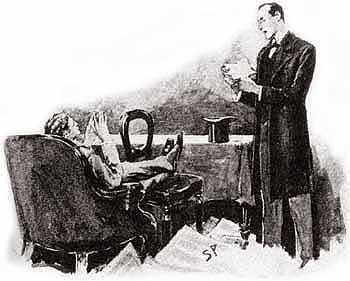Bassick: “Holmes again?”
Professor Moriarty: “Always Holmes until the end.”
The man is a music hall singer – a vaudeville performer in a gaudy jacket, adorned with large stripes in an array of undoubtedly ostentatious colors. A straw boater with a large brim, adorned with a ribbon that coordinates with his jacket, is clutched between his gloved hands, and he uses it in a variety of theatrical flourishes during his performance. He sports a handlebar mustache – complete with extravagantly curled, upturned ends – and slickly-styled hair with a pronounced side-part and subtle fingerwave along the brow. He prances energetically about the stage at a garden party, clicking his heels and leaping at appropriate intervals, as he sings a rather nasally-pitched version of the popular British music hall song, “I Do Like to Be Beside the Seaside.” The singer trills and trumpets, and drums upon his boater when the moment calls for it. As a performer, he is utterly outlandish, wildly outrageous, and completely entertaining. He is also Sherlock Holmes – sporting one of his best disguises in his long career on film.
 |
| Photo Credit: www.basilrathbone.net |
“The first of three possible endings has Holmes explaining how the vengeful Mateo believed that Ann’s father had been responsible for the death of his own, and had stolen the mine that had made the Brandons rich; meanwhile, Brandon family lawyer Jerrold’s shifty behaviour had been caused by his desire to shield Ann from the truth about her dead father. None of this crucial background information is conveyed in the finished piece” (21).
There are other contextual anomalies in The Adventures of Sherlock Holmes. Dr. Watson is inexplicably antagonistic toward the young page, Billy (Terry Kilburn – who, for some reason, receives top billing over George Zucco, the actor portraying Professor Moriarty), beginning by mocking the frilly, feminine apron that Mrs. Hudson has forced the boy to wear while doing chores. When Holmes good-naturedly points out the deficiencies in the boy’s housework (that Billy has swept the dust under the rug, rather than into the dustbin), the Doctor gives him an intimidating, unforgiving stare, while Billy stares back defensively. Watson is then positively hostile when Billy is able to provide a bit of opportune insight into a piece of evidence: “I’ve listened to seashells that made better sense.” The hostility isn’t solely confined to the Doctor, however. Sherlock Holmes behaves in an equally unfriendly fashion towards Watson, at one point calling him “an incorrigible bungler.” The Detective frequently interrupts his companion’s sentences, often providing his own piercing expression. At one point, Watson says, “You pushed me out of the room as if I were a child. What am I to make of this, Holmes?” And the audience may find themselves wondering the same thing. What are we to make of this?
The Adventures of Sherlock Holmes features George Zucco in the role of Professor James Moriarty (the 1942 film, Sherlock Holmes and the Secret Weapon would feature Lionel Atwill in the role). Zucco’s Moriarty is sedately evil, with undercurrents of roiling menace. He is not a villain that chases after his victims; he waits for them to come to him – as they inevitably do. According to Alan Barnes, “The most measured of crazies, [George] Zucco’s Moriarty makes a significant impression, enjoying another standout scene in which he dares the bullied Dawes to let slip a razor while shaving him: ‘You’re a coward, Dawes. If you weren’t a coward you’d have cut my throat long ago…’” (21).
oOo
Sources:
- Barnes, Alan. Sherlock Holmes on Screen. (September 2011).
“Better Holmes & Gardens” has its own Facebook page. Join by “Liking” the page here, and receive all the latest updates, news, and Sherlockian tidbits.




